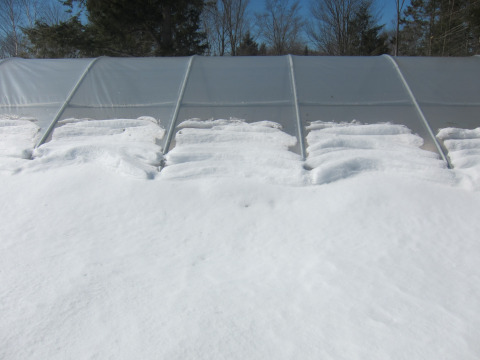In The First Place

Yeah, we still have just a little snow
I’ve been getting questions about our building plans, both here and privately. In part because of this, and in part because I can feel myself transitioning away from written creativity as my body and mind adapt to the physicality of the season, I thought I’d share some of the nuts and bolts of our forthcoming project. If you’re looking for my usual ponderous, navel-gazing pontificating about the joys of rural living, the shackles of institutionalized education, and the imprisoning nature of the contemporary extractive economy, well… you might’s well just stop reading now.
We are building a small-but-not-quite-tiny house, measuring 20×26 to the exterior foundation walls. This will give us a solid 18×24 “clear,” which is the inside-to-inside of wall dimensions. The house will be two floors, with a three or maybe even a four-foot knee wall on the second floor. As with many of our plans, factors like the exact height of our knee walls are a bit fluid, and the final outcome will depend on other factors, such as the size of the used windows we find to fit those knee walls.
By-the-by, I’ve found this flexibility to be the key in building on the cheap; the worst thing you can do if you’re trying to build on a budget is be inflexible regarding plans and materials. For instance, we’ve sourced all of our windows either used or (primarily) from contractors who got stuck with new windows that did not meet the inflexible needs of their affluent clients. All the windows we’ve purchased are high end – either Marvin Ultimate or Andersen 400 series – and we haven’t paid more than 30 cents on the dollar. Actually, in most cases, we paid much less. (as an aside – and I might have mentioned this before – I bought a bunch of windows off a contractor who told me that the average window bill on one of his jobs is 90 freakin’ grand, which is about 300% more than we’ll be spending on our entire house) Our windows will not all match, but we’re fine with that, and it’s yet another example of flexibility and acceptance of imperfection creating an opportunity for us. Beside, as the hyper-talented and delightfully-opinionated Richard Sachs likes to say, “imperfection is perfection.” Damn straight, and particularly so when it results in debt-free shelter.
The aspect of our project that’s proved most vexing to us is insulation. That’s because our needs are somewhat unique: Since we’ll be cooking only on wood, we need to generate a certain number of BTUs just to feed ourselves. This raises an interesting problem: If we make the house too tight and too well-insulated, it ain’t just our food that’ll be getting cooked. We’ll fry ourselves right outta the place.
For this reason, we’ve dispensed with a preliminary plan that included straw bales and other super-insulating techniques. We will use dense pack cellulose insulation, which from our perspective offers the best balance of insulating qualities, economics, and toxicity (or lack thereof). We’ll frame our walls in a modified Larsen truss design that’ll give us 8″ of insulation with very little thermal bridging. The roof will be straight 12-inch rafters. Honestly, I think we’re still risking making the place too-well insulated for our particular needs, but we’re willing to run that risk, since we can always crank open a window or two, or just strip down and go roll ’round in the snow bare ass nekkid (if that don’t keep you from stopping by unannounced, I don’t know what will).
There’s a lot more to say, but paying work is calling, so I’ll just add this. I had a revelation about shelter and shelter related systems a few years ago, when I was bemoaning the impending replacement of our solar storage batteries to an older back-to-the-lander who also lived off-grid (this was before we decided to grid connect our system and dispense with the batteries entirely). The batteries we were eyeing at the time were gonna run us about 5 grand, a chunk of change that was going to wipe us out financially and furthermore underscore our utter dependence on industry and its oft-rapacious practices. I mean, lead acid batteries don’t just grow on trees, know what I mean?
What do you do when your batteries need replacing? I asked.
Well, he said, I just replace the battery in my truck, and use the old battery for the house.
In other words, his system was so small and simple, and his expectations were so friggin’ modest that he wasn’t faced with a similar quandary.
I’m not saying we’re ready for a one-battery solar system (though the house will be off-grid, with about 400-watts of panels), but I took a lot away from his response, which is this: The answer isn’t creating complex “green” systems to replace complex “dirty” systems, as seems so common in this day and age, probably because if the answer isn’t complex, there’s not much profit in it.
Instead, maybe the answer is getting away from complexity in the first place.

Ben Hewitt's Blog
- Ben Hewitt's profile
- 37 followers



